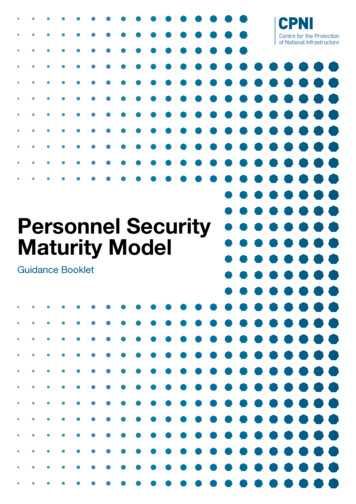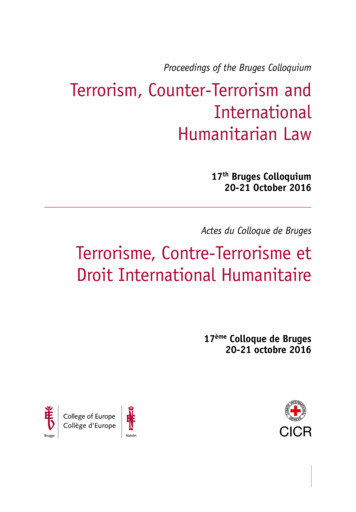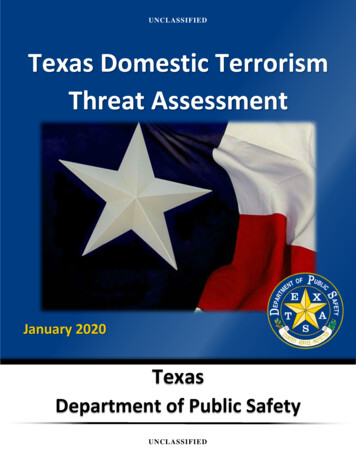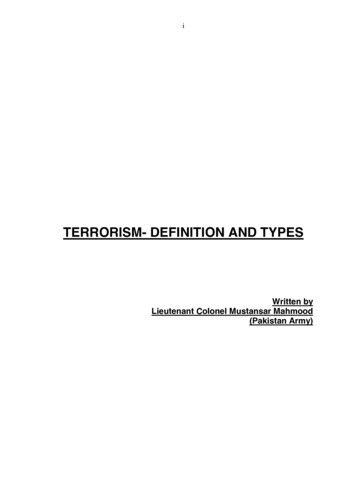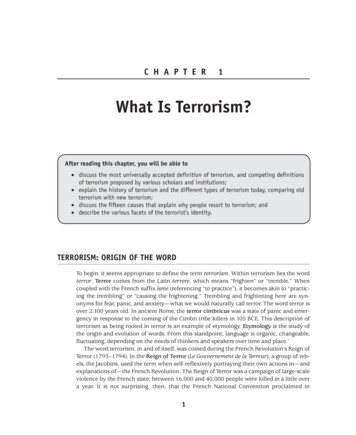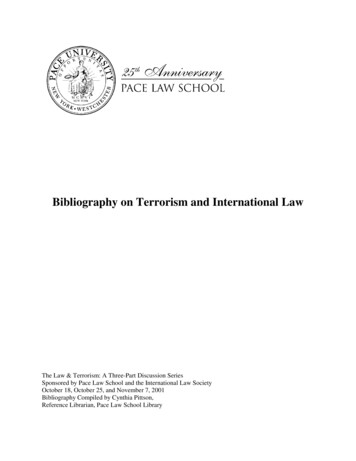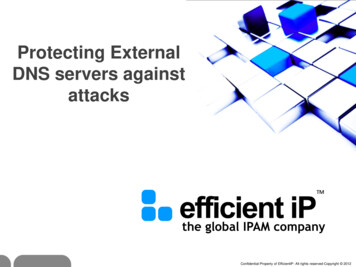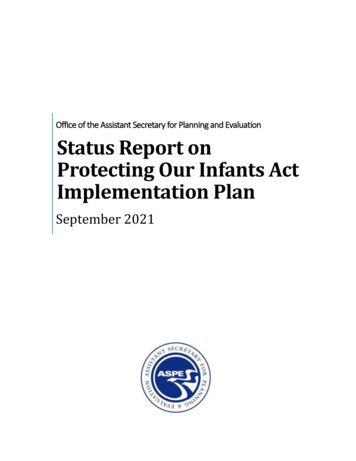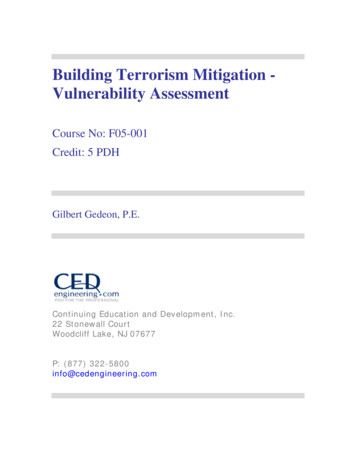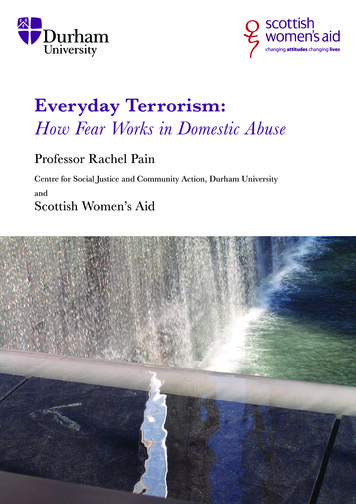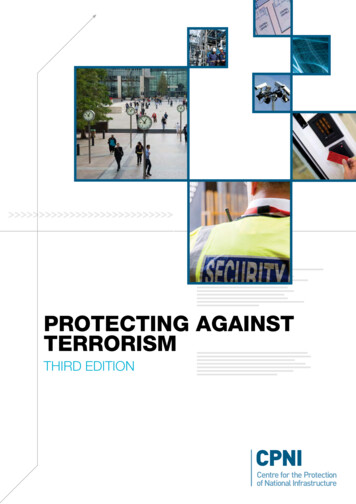
Transcription
PROTECTING AGAINSTTERRORISMTHIRD EDITION
Top TEN security guidelinesThe following protective security points summarise the guidance provided in this booklet.Whether creating, reviewing or updating security plans, keep these points in mind:1Conduct a risk assessment to decide on the threats the organisation might face andtheir likelihood. Identify existing and potential vulnerabilities and the impact of any breachesof security. See pages 11-122If acquiring or extending premises, consider security requirements right from the planningstage. It will be cheaper and more effective than adding measures later. See pages 13-263Make security awareness a part of the organisation’s culture. Ensure staff are keptregularly informed and that security standards are fully supported at a senior level.See pages 37-4445678910Ensure good basic housekeeping throughout the premises. Keep public areas tidy andwell-lit, remove unnecessary furniture and keep garden areas clear. See page 17Keep access points to a minimum and issue staff and visitors with passes. Wherepossible, do not allow unauthorised vehicles close to the building. See page 16Install appropriate physical measures such as locks, alarms, CCTV surveillance,complementary lighting and glazing protection. See pages 17-18Maintain appropriate mail-handling procedures, consider establishing the mailroom awayfrom the main premises. See page 18When recruiting staff or contractors, check identities and follow up references.See pages 23-26Consider how best to protect information and take proper IT security precautions.Ensure there are appropriate provisions for disposing of confidential waste.See pages 19-22Plan and rehearse business continuity and incident response plans, make sure that keybusiness functions can continue during disruptions. See pages 27-36
PROTECTINGAGAINST TERRORISMCONTENTSIntroductionImportance of security planningThe security plan235InformationIdentify the threatsThe vulnerabilitiesThe risk assessment77911Protective securityPhysical securityInformation securityPersonnel security13151923Response planningBusiness continuity planIncident responseCommunications planBomb threatsEvacuation planSearch planning27272931333435Security cultureStaff awarenessStaff surveysGood practice – security in the workplace37394143Protecting Against Terrorism1
Protecting against terrorismIntroductionThis publication offers security advice and good practice for anyorganisation looking to protect against the risk of a terrorist act orlimit the damage such an incident could cause.It sets out how a security plan might be developed and updated,the key measures that can help protect staff, property and informationand how businesses can prepare for the worst.Protecting Against Terrorism is an overview of the security advice thatderives from CPNI’s work with the national infrastructure. Although aimedprimarily at countering potential terrorist attacks, much of it representsgood practice for businesses of any size, whether private or public sector.It is intended as a starting point. Any major decisions or investmentrelating to protective security should always be taken in consultationwith the wider sources of advice and information that are available andreferenced throughout the following pages.What is CPNI?The Centre for the Protection of National Infrastructure (CPNI) is thegovernment authority that provides advice on protecting the country’sessential services, facilities and networks from terrorism and other threats.It is an interdepartmental organisation of experts and security specialists drawnfrom across government, police, the Security Service, academia and the privatesector. It provides advice and research across physical, information and personnelsecurity for the nine sectors that form what is known as the ‘national infrastructure’and which provide the services that support everyday life: Communications Financial services Health Energy Food Transport Emergency services Government WaterMore information about the work of CPNI, including someof the publications and guidance mentioned in ProtectingAgainst Terrorism, is available from www.cpni.gov.uk.Please note that previous editions of Protecting Against Terrorism were publishedby the Security Service (MI5). CPNI was formed in 2007 at which time it assumedresponsibility as the government authority for protective security advice.Protecting Against Terrorism2
Importance of security planningThere are sound commercial, legal and reputational reasonswhy organisations should keep security under constant review.IntroductionThe threat from terrorism to the UK remains both real and serious. An attack could takeplace at any time without warning and any organisation could be affected – from thedisruption caused by a suspect item found on its premises to, in the worst case, staffcaught directly in the midst of a violent attack.Acts of terrorism vary in terms of scale and purpose. Some seek merely to inflict superficialdamage or cause public distress to draw attention to a particular cause. But others carry amore malicious intent.Terrorism is not just about violent attacks on people and property. Disrupted communicationssystems, damaged assets and tarnished reputations can cause immediate and/orlong-term harm to a business and so equally desirable from the terrorist point of view.Threat to the UKThe most significant threat facing the UK comes from international terrorism and its statedambitions to mount ‘high impact’ attacks that combine mass casualties with substantialdisruption to key services such as energy, transport and communications. This is a threat thatis different in scale and intent to any that the UK has faced before.Northern Ireland-related terrorism also continues to pose a serious threat. Despite a peaceprocess that has been active for several years, dissident republican terrorist groups havecontinued to attack economic and political targets.Whilst anti-terrorism operations have achieved considerable success – in particular againstinternational terrorism (see CONTEST information opposite) – the intelligence accumulatedduring police investigations and subsequent trials reveals that terrorist groups, both at homeand abroad, continue to target UK citizens, businesses and interests.Wider threats to businessBusinesses also face a range of other threats that possess thepotential to cause significant disruption: activist groups drivenby political or social issues; organised crime; foreign intelligenceagencies looking to advance domestic interests; competitors seekinga commercial edge; an amateur hacker showcasing their skills; orpremeditated burglaries and opportunistic thefts. Even a memberof staff, present or former, with a score to settle or opportunity theycouldn’t resist could present a risk to a business.Prepared for the worstOrganisations need to be prepared. Even if thelikelihood of being directly targeted by terrorists areremote, the repercussions of an attack elsewherecan spread right across the economy. Could abusiness still function if, for example, key suppliersor clients were directly affected, if telephonenetworks went down or if power supplieswere cut? What if deliveries could not be madeor payments completed?3Protecting Against Terrorism
IntroductionNo single security response or level of investment will provide ‘total’ protection. Nor isit practical for a business to invest in every solution available on the market. However,a considered and up-to-date security plan, one that is appropriate to the organisationand in proportion to the risks it faces, can help to protect against the worst possibleconsequences.Good security is essential not only because it provides reassurance to staff, investors andclients, but because there are legal and commercial responsibilities to take into account:Health and safetyHealth and safety at work regulations place a legal responsibility on the owner or occupierof premises to have a ‘duty of care’ for staff and visitors. In the event of an incident, anysubsequent inquiry or court proceeding will look for evidence that the relevant legislationwas followed.Business continuityIn the event of an incident, organisations must aim to return to ‘business as usual’ assoon as possible. This is particularly important for smaller businesses which may lack theresources to withstand more than a few days without trade.Loss of reputationThe reputational damage of a security breach is something that will concern all seniormanagement – the loss of trust following a failure to protect staff, clients or even data mayprove difficult to recover.CostsLost or destroyed assets may need to be replaced quickly and at great cost. This is inaddition to any losses that might be incurred through the suspension of normal business.Find out more.CONTEST – The UK government’s strategy for counteringinternational terrorismCONTEST is the government’s comprehensive strategy to reduce the risk we face frominternational terrorism. Launched in 2003, and revised in 2009, it is based upon four keyelements: Pursue, Prevent, Protect and Prepare.The strategy involves thousands of people – intelligence officers, the emergency services,local authorities, businesses, voluntary and community organisations, governmentsand other partners – working in partnership at an international, national and local level.For more information about the UK counter-terrorism strategy visitwww.security.homeoffice.gov.ukProtecting Against Terrorism4
The security planA security plan should be informed, integrated and multi-layered.IntroductionBusinesses cannot remove all of the threats they may face, but they should possess a planto protect their most valued assets and prepare their response to major disruptions.Security planning must not evolve in an arbitrary or ad-hoc manner, nor develop solely fromprevious mistakes and errors. To be effective, plans must be built on information aboutalmost every aspect of the business both now and into the future. It must be fully integratedwith everyday operations, supply chains and routines. And it needs to be ‘multi-layered’ –where each measure is reinforced by the next.The structures and terminologies will differ from one organisation to the next but each plan shouldbroadly consist of the following components:Information:An assessment of the business and the environment in which it operates – the threats,the vulnerabilities, its most valued and critical assets.Protective security:The measures that protect against identified threats and vulnerabilities.Response planning:How the organisation will respond in the event of disruption.Security culture:Building security awareness across the organisation.Developing a security planInformation (page 7)Identify the threatsPriorities for protectionRisk assessmentProtective security (page 13)Response planning (page 27)Physical securityInformation securityPersonnel securityBusiness continuityEvacuation plansIncident responseSecurity culture (page 37)Staff awarenessStaff surveysBest practiceLarge, multi-site organisations might operate separate plans for each location to reflectlocal structures and activities in addition to an overarching plan setting out commonactions and inter-dependencies.5Protecting Against Terrorism
IntroductionOwnershipA security plan needs to be a working document where every aspect is constantly reviewedand updated in response to organisational changes in circumstances. For any plan to keeppace with issues as they arise it must be formally owned by a member of staff who can takeon the responsibility for overseeing arrangements and who possesses the authority toco-ordinate actions.In larger organisations this might be the role of a dedicated member of staff with board-levelstatus or a direct report to the board, possibly with the support of a specialist team. In smallerorganisations it should be someone with similar influence and understanding of the business.Whoever manages the plan will need to take full interest in almost every aspect of thebusiness. From recruitment to IT policies, from outsourced services to new building andrenovation work – there are security implications to almost every major decision.Senior management supportWhatever the size of the organisation, it is crucial that the plan carries the full support of seniormanagement and that this is communicated throughout the business, particularly where certainmembers of staff carry delegated responsibilities. In the event of an incident, the authority ofthose responsible for co-ordinating the response must be clearly understood by all staff.CollaborationThe exchange of advice and information is an important part of all security plans.The opinions of senior management and staff across the organisation will be essential,but so too will be contributions from those outside the business such as the emergencyservices, neighbouring businesses and specialist experts (structural engineering, IT etc).ConfidentialityThe security plan will contain some of the most sensitive information available about thebusiness and so it is important to be clear who has full access and how it is distributed.This applies to internal staff as much as when consulting the opinions of external partners.The following pages in Protecting Against Terrorism offer a guide to some of the pointsto consider when developing and maintaining a security plan. More detailed advice onevery aspect is available from www.cpni.gov.uk. Other relevant resources are highlightedthroughout the document.The starting point is to gather as much information as possible about the diverse threats acompany might face in order to carry out a risk assessment exercise.Find out more.For further advice on producing security plans:Secure in the knowledge – building a secure businessavailable from both: www.cpni.gov.uk and www.nactso.gov.ukSee adeinvest.gov.uk/ukti/osib(Overseas Security Information for Business (OSIB))Protecting Against Terrorism6
Identify The threatsWhat puts an organisation at risk?InformationSome businesses will be more ‘at risk’ than others because of the services they provide,their relatively high profile or the number of people they accommodate. But the impacts ofany attack are rarely confined to the target and other businesses and communities can findthemselves adversely affected as the full implications spread.Organisations need to understand the range of threats they face, both direct – wherethe business itself is the target – and indirect, from the comparatively low-key to thecatastrophic.DirectBusinesses should be constantly asking what it is about their operations or circumstancesthat could put their staff or key assets directly in harm’s way. For example: What is the nature of the business or the services provided? Is there anything on site that could represent a valuable target e.g. materials, data, plans,technical expertise? Is the business associated with a high profile individual or a contentious area of work? Does the organisation maintain visibly high standards of security?In short, how likely is it that the business, or its staff, could be the direct target of apre-meditated attack?IndirectThere may also be the indirect impacts that result from an attack elsewhere – where thebusiness itself was not the target but finds itself dealing with the consequences.For example, are the business premises located near an iconic, high-risk building? If so,how would it affect operations if the entire area could not be accessed for several days?Would staff be able to travel if the local transportation network was severely disrupted?Are IT networks able to react to the suddenemergence of a new virus or vulnerability?Could an incident in another city, or another country,cause significant problems for suppliers, clients or thedelivery of essential materials?Other social factors can also increase the threats to abusiness. Would concerns about job security amongstthe workforce raise the risk of employees stealing orselling information?7Protecting Against Terrorism
InformationThe wider pictureA threat assessment should not limit itself to information obtained only frominternal resources. It should also take advantage of external sources of information.Consult neighbouring businesses and trade associations to find out what they judge to bethe major risks to the local economy. Request details about the security standards appliedby key suppliers to the organisation. And contact the local authority for any contingencyplans and other relevant information provided for businesses in the area.Keep abreast of current affairs through the media and maintaina regular check of current government advice about the generalsecurity climate.The following websites serve as useful sources of information tocheck e Reduction Officers – contacted through the local policeservice – can provide advice about general crime prevention.Organisations with a particular concern about being a target forterrorism should also make contact with their local Counter TerrorismSecurity Advisers (CTSAs – see below).Attend one of the local Project Argus briefings held around the country. These are freeevents open to any business during which attendees – managers and their staff – are guidedthrough a simulated terrorist attack in order to help understand their reactions and to planinitial responses to an incident. See www.nactso.gov.uk/argus.php for more information.The threats to an organisation will constantly evolve so the overarching aim should be tonot only understand the scale of the threat, but also to stay alert to changing internal andexternal factors so that assessments can be regularly updated.Find out more.Counter Terrorism Security AdvisersCounter Terrorism Security Advisers (CTSAs) are a network of specialist policeadvisers who assist businesses and services that might be vulnerable to terrorist orextremist attack; this includes ‘crowded places’ such as shopping centres, sportingstadia, pubs, bars and hotels.There are around 250 CTSA officers, at least two for every police force area,who are specifically trained in areas such as explosives, pathogens and toxins,radiological sources and security surveying.For more information about the work of CTSAs, to download theirpublished advice or attend one of their Project Argus events mentionedabove visit www.nactso.gov.uk.Protecting Against Terrorism8
The vulnerabilitiesWhich areas of the business should be a priority for protection?InformationWhen deciding what should be protected it might help to use the following categories: People – staff, visitors, contractors, customers. Physical assets – buildings, contents, equipment and sensitive materials. Information – IT systems, online transaction systems, electronic and paper data. Processes – supply chains, critical procedures, production cycle.Organisations need a clear consensus about those assets which they regard asvaluable and those they regard as essential.Most valuable1 Those assets which the organisation has a duty to protect – staff, client services,production systems etc.2 High-value assets that are worth additional or specific security investment.3 Unique assets which, though not necessarily of a high monetary value, would bedifficult to replace.Some priorities will be obvious with plans and provisions already in place. But it wouldbe wrong to assume everything has been identified and appropriately secured. As with thethreats, values can change with some assets continuing to be worth the protection they areafforded whilst others, in terms of security resources, may have become undervalued.Most essentialThe most valuable assets may not necessarily be the most essential.The latter are those assets – equipment, information systems, transportation etc – vital tothe day-to-day running of the businesses which, if lost or compromised, could have majorimplications for other parts of the business.The task of identifying which assets are the most essential should not be completed throughdiscussions amongst management alone. Staff across the organisation should be consultedabout how the temporary loss of their department and its services will impact the business.Though all staff will contribute to the normal running of business, not all will be essential fordelivering the basic services.Making decisions about what is essential is also a key part of theBusiness Continuity Plan (see page 27).9Protecting Against Terrorism
In addition to protecting key assets there is also the need to identify where existing securitymeasures need to be improved.This involves an honest appraisal about how current security measures are performing andwhether they remain sufficient or are leaving areas of the business exposed. The securitymeasures in place may still perform to their specifications but have simply been outgrown bythe organisation.Questions businesses should ask include: Have new methods or technologies emerged that will improve existing security? Is existing security sufficient for any planned business expansion? Are mobile devices being responsibly used by staff? Do all areas of the business undertake consistent pre-employment checks? Is there an increased rate of staff turnover – is it expected to rise? Are staff able to take valuable data offsite without approval?Security planning depends upon honest assessments. Past failures should not be brushedunder the carpet. Have any records been kept about previous security breaches or ‘nearmisses’? Does this reveal any patterns or highlight occasions where procedures did not workbut nothing was done about it?There may be other reasons why the business, or part of it, is vulnerable because groups orindividuals may be able to exploit them. For example: Does the company website provide too much detail about the business and how it operates? Is there anything that identifies installations or services vital to the continuation of the business? Is there sufficient separation of public areas and operational areas? Are outsourced services in safe hands – what are their security standards? Are goods delivery areas exposed – is there sufficient control of who comes in? Do procedures require passes to be returned and user accounts closed when staff leave? Do external parties enjoy privileged access to property or information?Find out more.For further advice on assessing vulnerabilities in the ov.ukwww.thebci.org (The Business Continuity gov.uk/secureyourbusinessProtecting Against Terrorism 10InformationExisting vulnerabilities
The risk assessmentDecisions about security should take account of the threats,vulnerabilities and potential impacts.InformationIt is not practical to commit to fully protecting every aspect of the business all the time.Instead, major decisions about protective security measures or changes in procedure shouldonly be taken following a full risk assessment. This involves a strategic analysis of thethreats, vulnerabilities and the potential consequences to the business in order to identify themost important risks on which to focus resources.Basic principlesThe risk assessment process involves making logical assumptions about the likelihood of a threatand its potential impact should current security measures fail to protect it.Though it is not possible to predict all possible threats to a business, by working through arange of potential scenarios and consequences that could happen it becomes possible to makeinformed judgements about priorities for the business.There are various ways to carry out a risk assessment exercise and each organisation and/orlocation should use its own methodology as appropriate, but the process is likely to be based onthe following principles:1Having identified its key assets (pages 7-8) the first step for the organisation is to use theinformation gathered in its threat assessment to identify the possible risks it faces, ranging fromthe catastrophic to the relatively minor: A bomb in, or near, the main building entrance. A suspect package received through the post. An employee using their access to sell confidential information. A virus introduced into the main IT system. An employee discreetly transferring small funds to an unauthorised account.The pages on physical, personnel and information security measures (pages 13-23) providefurther examples – use a balanced representation from all three or undertake a separateexercise for each.2Allocate a simple score to denote the potential impact of each incident based upon anassumption about how it will affect the business (e.g. whether it could cause injuries andfatalities, financial losses, impact on productivity, reputation and client confidence).Use a suitable scale for the business, e.g. score ‘5’ for the worst possible outcome – it isalmost certain that lives will be lost or buildings put out of use – but score ‘1’ if it is likely theincident may be easily contained or recoverable at little cost and without publicity.3For each scenario put a second score representing the likelihood of the incident happeningat each location. Consider why and how it could happen and how current security measuresmight perform (see pages 7-10).Apply a similar consistent scoring system above, such as 1 (‘extremely unlikely’) to 5 (‘certain’).For example, the likelihood of petty theft may score 5, but the chances of discovering anexplosive device in the building may score 1.11 Protecting Against Terrorism
Information4When the two scores for each scenario are comparedagainst other scenarios it starts to reveal the threats onwhich the business should focus.It might help to plot the points on a 5x5 matrix using impactand likelihood as the axes. Best practice recommendslooking at the scores in isolation – don’t multiply them intoa single figure as this can obscure results (i.e. a petty theftscores the same 5x1 as a bomb 1x5).These scores are only indicative and the eventual actionsagreed might still be swayed more by either the potentiallikelihood or impact, but this process should help to focusdecisions. This exercise should be revisited regularly so that any changes in threat andvulnerability can be taken into account.For more guidance about conducting risk assessments see Risk assessment forpersonnel security – and Guide to producing operational requirements for securitymeasures available from www.cpni.gov.uk.Appetite for riskWhatever the method used to conduct the risk assessment it might help to categorise threatsinto a ‘risk appetite’, for example:ProtectAreas where changes or improvements to current measures are necessary,either through new equipment or procedures.AdaptRisks that could be reduced through operational changes e.g. outsourcing,change of routines.AcceptRisks judged as minimal where costs of mitigation/change outweigh benefit.Contingency Risks that will require plans to ensure there are alternatives or reserves –particularly assets deemed as essential to operations.From this point an organisation should look at the strategies it needs to develop: the protectivemeasures that can protect its interests and the response plans to ensure any incidents areefficiently managed.Find out more.For further advice on risk ww.theirm.org (The Institute of Risk Management)Protecting Against Terrorism 12
Protective securityProtective securityPhysical, information and personnel security measures shouldcomplement and support each other.What is protective security?The most effective security response is likely to include a combination of physical,information and personnel security measures. Together, they work to secure a businessthrough a mix of deterrence and detection, or by helping to minimise the consequencesof any attack.But all organisations are different – as are the sites and locations of which they comprise– so the appropriate mix of measures will depend on the nature of the risk-led assessment ofthe threats and vulnerabilities in each location.Physical securityPhysical security comprises the various installations, measures and controls that protectagainst an actual physical attack. For example: Intruder detection and alarms Access control systems Security guarding Hostile vehicle mitigation, including vehicle security barriers Blast protectionInformation securityInformation security measures aim to protect an organisation’s data and its various formsof storage and distribution. This includes protecting IT systems against electronic attack aswell as measures to secure information stored on mobile devices or paper: Network access control measures (typically enforced by ‘firewalls’) Electronic attack intrusion detection and prevention Identification and authentication measures (e.g. username/password)Personnel securityPersonnel security is about managing the risk of staff or contractors exploiting theirlegitimate access to an organisation for unauthorised purposes: Identity checking and pre-employment screening Risk assessment procedures Ongoing security measures13 Protecting Against Terrorism
Instead, security should be developed around a ‘multi-layered’ principle where each layersupports the next and all working seamlessly together.Appropriate and proportionateSecurity measures can be resource intensive, costly and, if not carefully managed, can disruptroutines and alienate members of staff. This is why careful consideration and planning isrequired when choosing the right response and why specialist advice should be sought.As a general guide, the following principles should be central to any decisions:1 It is not possible to protect everything so prioritise the areas to
regularly informed and that security standards are fully supported at a senior level. See pages 37-44 Ensure good basic housekeeping throughout the premises. Keep public areas tidy and well-lit, remove unnecessary furniture and keep garden areas clear. See page 17 Keep access points to a minimum and issue staff and visitors with passes. Where
